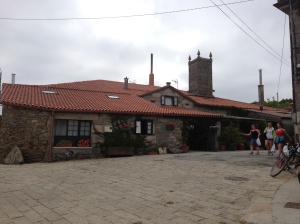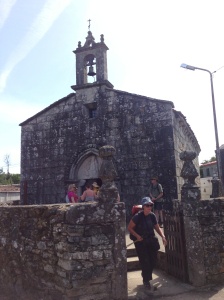Stage 34 – Palas De Rei – Castañeda
Total Distance – 22.8 km (14.1 miles)
Adjusted for Climb – 23.7 km (14.7 miles, accrued ascent 180 m = 0.9 km)
High Point: O Coto at 515 m (1,670 feet)
CLICK ON THE PICTURES TO ENLARGE TO FULL-SIZE
Please note that some names may be in Galician – you’ll now it when you see it.

A short distance out of Palas de Rei we met an Australian couple. Notice the Hórreo to the left of the couple. Sue is carrying her red backpack.
Our stay in Palas de Rei (pop. 4,500) was pretty uneventful. I’m guessing because at this point we were so close to Santiago that our energies were focused on finding a place to sleep, eating and not injuring ourselves by doing something stupid, such as tripping over a curb or missing a step. Of course these were everyday concerns on the Camino but they became magnified once you realized just how close you were to your goal. Getting to Santiago was always an obession but now it became even more of one. For some reason I ran into more Australians and walked with them than any other nationality on the Camino. I was even beginning to talk like them!! This day was no different as Sue and I quickly encountered an Australian couple and started walking with them.
Not only were we about to enter a new province, A Coruña, but we also on this day would cross five river valleys. They were small shallow rivers, and the valleys were green and verdant.
At the village of Leboreiro, a once important place from the 11th to 13th centuries and called “Campus Levurarius” (Rabbit Field) by the Codex Calixtinus, we stopped to enter the 13th century Church of Santa Maria. Rebuilt in the 18th century this church has an interesting legend attributed to its founding. It was said that a nearby fountain was emanting a “heavenly odor” and at night a “shining light”. Villagers, seeing this as a sign from above, proceeded to dig at the source of this divine intervention and found an image of the Virgin Mary there. They immediately placed it on the altar of the church. The one catch was that the image would not stay where it was placed and somehow returned to the fountain. This pattern repeated itself over several days until the villagers carved the tympanum we see here today and dedicated the church to the Virgin Mary. Satisfied, the image of the Virgin remained on the altar and has been in the church ever since. To add to the legend, it was believed by villagers in the 1960’s that the she returned to the fountain every night to comb her hair.
The church also has some interesting Romanesque design elements supporting the roof, corbels, and “including one very obvious phallus”. I must of missed this since I don’t remember it and I’m sure I would not have forgotten something like that in a church! Next time.
At the Ponte Velha we stopped for our most distinctive sello of the Camino. It was a wax sello! A gentleman at the bridge melted the wax before our very eyes and used a bronze stamp to produce a wax sello. Many people stopped for it and as you can see on the left of the above photo it drew quite a crowd. Once we had crossed the bridge we were in the modern surburbs of Melide. Melide is an adminstrative center of 8,000 inhabitants but more importantly for peregrinos it is famous for its octopus! After saying goodbye to our Australian friends who were doing a short stage and staying in Melide Sue and I hightailed it to the Pulpería A Garnacha, one of the many famous restaurants that specialized in pulpo Galega (octopus) where we had a meal of octopus, sprinkled with pimentón ahumado (smoked paprika), and local ribeiro white wine. It was delicious and is what is done in Melide!
Melide is and was not only pulpo Galega. This was the place where the Roman Via Traiana and the Cantabrian roads intersected and as such Melide became an important transportation center. Furthermore Melide is in the exact geographic center of Galicia and not unusually it became an important town for pilgrims hosting businesses, hospices and hospitals.

The Cruciero that stands in front of the Santa Maria de Melide Church located on the way out of town.
After pulpo and wine it was time to move on and our next stop was the Santa Maria de Melide Church. At first we weren’t sure we’d be able to see the church because the doors seemed shut but we soon found a man that was able to open the church for us. This church is a Romanesque gem and is a national landmark even though I didn’t see any indication of its landmark status. It is reputed to be the most complete example of the Romanesque style in the area and one look confirms that it is the best preserved and maintained as well. The church was constructed of granite in the 13th century and it has a “single nave, ending in a semi-circular apse in its apse, with a cul-de-four, decorated with Renaissance paintings.”
The church has many, many more interesting features, inside and outside, that we didn’t know of at the time and I wish we could have stayed there longer to have enjoyed them all but the pull of the Camino was calling.
 Very, very soon thereafter we stopped in the village of Carballal mainly to photograph a beautiful stone house. Living in California, as I do, you do not find any stone houses because of our earthquakes so you can imagine how taken I was with this house.
Very, very soon thereafter we stopped in the village of Carballal mainly to photograph a beautiful stone house. Living in California, as I do, you do not find any stone houses because of our earthquakes so you can imagine how taken I was with this house.
Our final destination was the hamlet of Castañeda and the casa rural that we’d booked for the night. Since it was about 8 kilometers away and we decided to hurry along so that we’d have plenty of time to shower and rest before dinner. We found Castañeda to be the epitome of a rural farming community and one would have never guessed that this was the place where pilgrims would deposit the limestone rocks that had carried with them from Triacastela to be fired for the lime used to construct the Cathedral of Santiago. Who knew?!

 After refreshing and reviving showers both Sue and I were ready to cross the street to the Cafe Bar Santiago and have some typical pilgrim fare for dinner. It consisted of a meat, french fries (the go to carb of choice on the Camino), plenty of wine (another Camino tradition) and ice cream for dessert. On the patio we noticed a couple, consisting of a man in his late 30’s and a woman in her 60’s, and asked if we could join them for dinner. Shamus was an Anglo-Irish doctor who had started his Camino in St. Jean Pied de Port. Interestingly his specialty was infectious diseases, mainly tropical ones. He had met his Irish mother in Sarria so that they could walk into Santiago together. We enjoyed our conversation and I asked Shamus what it was like being a doctor on the Camino. His reply can be best summed up in one word, “frustrating”. We all know that doctors are trained to diagnose and help and when, in passing conversation, peregrinos would learn that Shamus was a doctor they would invariably ask him to see an injury that they were struggling with and advise them. Shamus would check their injury and his advice was always the same: “You need to stop walking”. Some cases he said could produce a lasting injury. The response that he got was also invariably the same: “I can’t stop”. I did not find this surprising because I too faced off with an injury to my achilles tendon but I stopped and fully rested for three days before continuing on, in less pain but some pain nonetheless. This familiar pattern of sound medical advice and the rejection of the advice was very frustrating to Shamus because after all he was telling them what any doctor would of told them and had they been at home they would of taken his advice. Here on the Camino his medical knowledge was trumped by the overwhelming urge to arrive at Santiago. I really felt for Shamus and no wonder that he was reluctant to give advice anymore on the Camino! The lesson here is that if you are a doctor walking the Camino you need to be prepared to be frustrated or you will need to keep your profession secret. I’m glad I’m not a doctor!
After refreshing and reviving showers both Sue and I were ready to cross the street to the Cafe Bar Santiago and have some typical pilgrim fare for dinner. It consisted of a meat, french fries (the go to carb of choice on the Camino), plenty of wine (another Camino tradition) and ice cream for dessert. On the patio we noticed a couple, consisting of a man in his late 30’s and a woman in her 60’s, and asked if we could join them for dinner. Shamus was an Anglo-Irish doctor who had started his Camino in St. Jean Pied de Port. Interestingly his specialty was infectious diseases, mainly tropical ones. He had met his Irish mother in Sarria so that they could walk into Santiago together. We enjoyed our conversation and I asked Shamus what it was like being a doctor on the Camino. His reply can be best summed up in one word, “frustrating”. We all know that doctors are trained to diagnose and help and when, in passing conversation, peregrinos would learn that Shamus was a doctor they would invariably ask him to see an injury that they were struggling with and advise them. Shamus would check their injury and his advice was always the same: “You need to stop walking”. Some cases he said could produce a lasting injury. The response that he got was also invariably the same: “I can’t stop”. I did not find this surprising because I too faced off with an injury to my achilles tendon but I stopped and fully rested for three days before continuing on, in less pain but some pain nonetheless. This familiar pattern of sound medical advice and the rejection of the advice was very frustrating to Shamus because after all he was telling them what any doctor would of told them and had they been at home they would of taken his advice. Here on the Camino his medical knowledge was trumped by the overwhelming urge to arrive at Santiago. I really felt for Shamus and no wonder that he was reluctant to give advice anymore on the Camino! The lesson here is that if you are a doctor walking the Camino you need to be prepared to be frustrated or you will need to keep your profession secret. I’m glad I’m not a doctor!
















